Process
What is Granite?
Granite is an intrusive igneous rock found throughout the Earth’s crust at depths of up to 31 miles (50 km). The distinctive granular structure and strength of granite are the consequence of many separate crystalline formations that develop tightly together as magma slowly cools within massive, deeply buried rock masses known as plutons. True granite is composed of 20-60% quartz and both plagioclase and alkali feldspars, with the latter not exceeding the general balance.
Granite is an intrusive igneous rock found throughout the Earth’s crust at depths of up to 31 miles (50 km). The distinctive granular structure and strength of granite are the consequence of many separate crystalline formations that develop tightly together as magma slowly cools within massive, deeply buried rock masses known as plutons. True granite is composed of 20-60% quartz and both plagioclase and alkali feldspars, with the latter not exceeding the general balance. Other minerals, like hornblende and biotite, may also be found in granite, explaining its diverse look (Alden 2004). Commercially, the term “granite” refers to a variety of non-granite dimension stones, such as any feldspathic crystalline rocks or other igneous or metamorphic rocks that have properties similar to granite’s gritty, interlocking texture.

On the commercial market, many variants of granite are available, with white, gray, pink, and red being the most prevalent primary colors. Granite colors also include darker shades of greens, browns, grays, and black.
Extraction And Block Selection
Extraction (also commonly known as quarrying) removes blocks or bits of stone from a previously identified and excavated geologic deposit. Differences in quarrying processes are frequently caused by variations in the physical features of the deposit itself, such as density, fracturing/bedding planes, and depth.
The first step in quarrying is to gain access to the granite deposit. This is achieved by using heavy machinery to remove the layer of Earth, plant, and rock unsuitable for a product and transporting it to onsite storage for later site reclamation. After the face of the granite is exposed, the stone is extracted from the quarry in benches that are typically 8 to 12 feet square and stretch 20 feet or more, using various procedures appropriate to the geology and properties of the granite deposit.
Quarrying processes usually include:
- Drilling holes along the perimeter of the bench.
- Cutting the stone out of the deposit with diamond-wired saws.
- Splitting the stone with hydraulic splitters or small explosive charges.
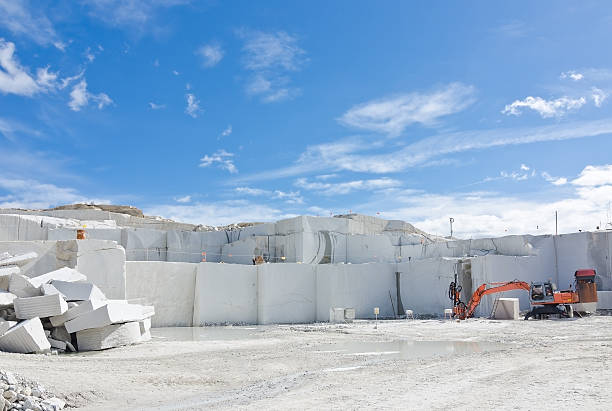
Heavy equipment is required to lift the granite bench and transfer it to an inspection area for quality and size criteria once it has been cut or split loose from the deposit.
Every block that meets the size requirement is thoroughly inspected for quality. We have the most experienced individuals visiting the quarry and evaluating blocks that will be further processed, including the directors. The blocks are examined for fractures, fissures, color patterns, and other variances that aid in selecting the best blocks for processing. Only one out of every ten blocks is chosen, guaranteeing that only the most premium blocks are chosen.
Block cutting
The first step of the process is a primary cutting or shaping of the material. For granite, this is usually done with a diamond wire saw. A continuous jet of water across the saw is essential when operating a circular or diamond wire saw to dissipate the heat created by the process; a sufficiently elevated temperature can cause severe equipment and material damage.
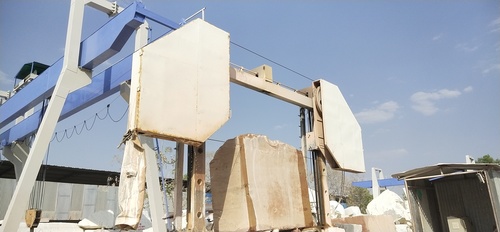
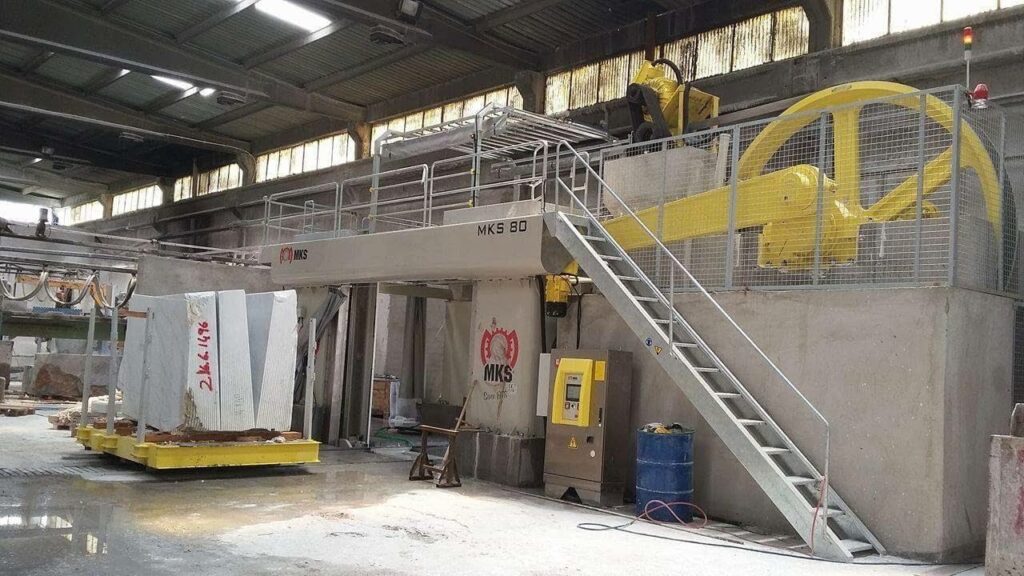
Gang-saw
After the wire saw has shaped the block, the matting is applied to guarantee there are no cracks or breaks during the cutting process. The gang-saw machine’s blades are set according to the hardness of the rock and the thickness specification for cutting, accounting for the loss of thickness during cutting and later processing. To ensure no movement throughout the cutting process, the granite block is loaded into the tray, packed with cement, and allowed to dry for a day.
Cutter
Once the block has been shaped, it is moved to the cutter machine. The width of the blades is adjusted to meet specifications. Cutter machines range in size from single blades to ten blades in one unit. The more edges there are on a block, the faster the cutting process. On the other hand, single-blade cutter machines process blocks of non-standard size/thickness.
A stream of distilled water is sprayed during the cutting process to absorb any heat dissipating from the cutting process and to minimize any sparks. The blocks are cut until only a few inches remain, and then a team of stone specialists cuts and extracts the slabs one by one from the cut block. The slabs are then thoroughly inspected for flaws, numbered for inventory monitoring, and relocated for further processing.
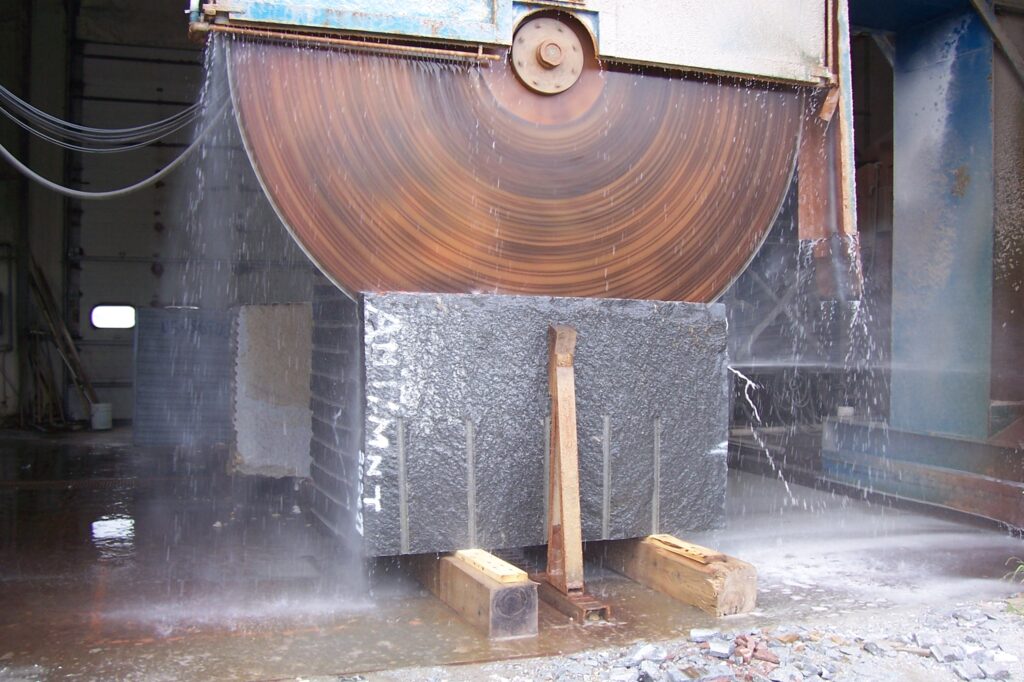
The tray containing the granite block is then transferred to the gang-saw machine. The slurry, a mixture of water, lime, and grit, is used in the cutting process to help gut the block and absorb any heat dissipated during the cutting operation. The slurry’s viscosity is constantly monitored and changed for each material and during the cutting process.
The machine and the block are inspected and re-adjusted every 2-3 hours to provide a constant and straight cut for the blocks. After the slabs are cut, they are inspected for flaws, individually marked for inventory monitoring, and transported to the next processing stage.

Grinding
The slabs are sent for grinding once they are cut and labeled. Grinding is a process that smoothens the granite surface, removing the gritty finish left over from the cutting process and achieving a smooth-to-touch finish.
Grinding is done in a grinding machine with multiple heads attached to diamond abrasives of different densities to achieve an even surface finish. Water is used again in this method to reduce frictional heat.
Epoxy application
The epoxy resin is used to fill all the natural pits and micro-fissures and hardens the stone even more. This method ensures that granite ages properly and lasts longer while retaining its original beauty. The right combination of the granite’s color and the epoxy with which it is combined will also help to showcase the granite’s natural color and pattern.
Before being treated, the surface of a granite slab must be heated to allow the rock to absorb the resin more deeply. The material must be thoroughly clean and dry for the resin to enter the surface’s small fractures. A wide range of epoxy chemicals is combined with the appropriate color, and application type is also required to produce the greatest finish.
he resin is then applied, spread on the whole surface, and reheated to ensure deeper penetration of epoxy. The slab is then allowed to cool while the epoxy hardens the granite slab further.
Many times, a test slab is used with the application of a range of epoxy on different parts of the slab to see the best outcome for each epoxy and finalize one for that block to find the appropriate combination for a granite color and epoxy match.
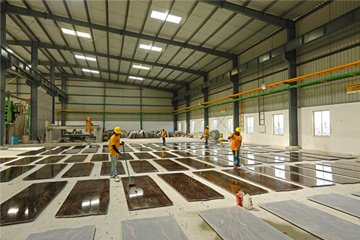

Polishing
This is the final step before the granite slabs are finished. This procedure eliminates excess resin from the granite surface and smoothens the finish.
In the polishing machine, the slabs are processed with special silicon carbide abrasives and undergo varying hardness and pressure with 21 abrasives to achieve a smooth surface finish and a mirror-like shine.
